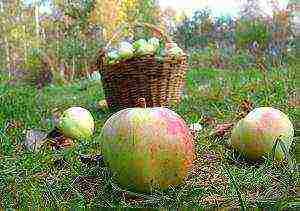Content
- 1 Garden balsam (Impatiens balsamina)
- 2 Waller's balsam (Impatiens walleriana)
- 3 Hocker's balsam (Impatiens hawkeri)
- 4 Balsam New Guinea (Impatiens Neuguinea)
- 5 Growing balsam from seeds
- 6 Balsam varieties for outdoor and home cultivation
- 6.1 Waller's balsam
- 6.2 Balsam Tom Tamb
- 6.3 Balsam Camellia
- 6.4 Balsam New Guinea
- 6.5 Balsam Safari
- 6.6 Balsam Cutie
- 6.7 Balsam Strawberry with cream
- 6.8 Balsam dwarf Exotic
- 6.9 Balsam Kandy
- 6.10 Balsam Carmelita
- 6.11 Balsam Super Elfin
- 6.12 Balsam Eurasia
- 6.13 Balsamin Bambina
- 6.14 Balsam Boy with a finger
- 6.15 Balsam Impreza
- 6.16 Balsam Acrobat
- 6.17 Balsam Lollipop
- 6.18 Popular species and varieties
- 6.19 Highlights of grooming and reproduction
- 6.20 The use of balsam in landscaping
- 7 Indoor balsam: photo and description of flowers
- 8 Growing indoor balsam from seeds
- 9 How to care for indoor balsam flower
- 10 Planting and caring for indoor balsam in winter, pruning a flower (with photo)
- 11 Pests of indoor balsam and their photos
- 12 Home care for New Guinea and terry balsam
- 13 Varieties of balsams of New Guinea and terry species with photos and names
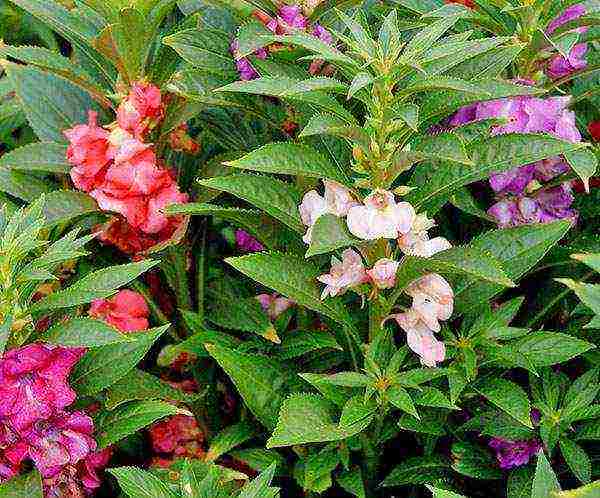 Balsams, or touch-me-nots, are a vast family of plants native to Asia and Africa, but native to virtually every corner of the world. In the genus of several hundred species, there are annual and perennial, two-meter and very small plants.
Balsams, or touch-me-nots, are a vast family of plants native to Asia and Africa, but native to virtually every corner of the world. In the genus of several hundred species, there are annual and perennial, two-meter and very small plants.
With all the differences in appearance and habitat, balsams, as in the photo, bloom magnificently, therefore they are grown as ornamental plants both in gardens and on home windowsills.
True, among the cultivated species in Russia, only a few have been able to become truly popular so far. This is a garden balsam, Waller's balsam, suitable for indoor and garden cultivation, as well as New Guinea balsams, which are gaining more and more fans, with unusually large flowers of bright colors.
Garden balsam (Impatiens balsamina)
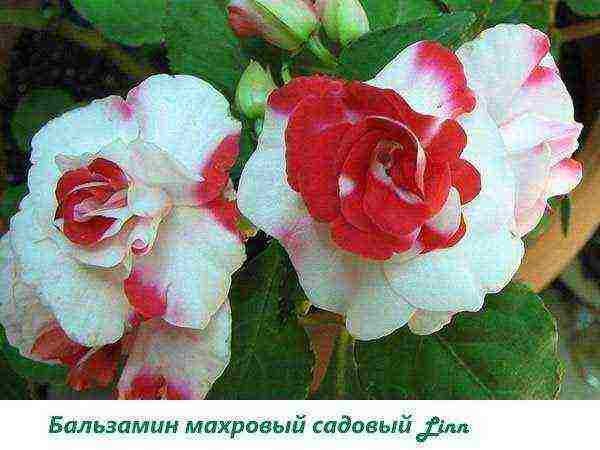 This type of balsam can be considered the oldest cultivated. Descriptions and the first images of medium-sized, from 25 to 70 cm in height, annual plants literally clung to simple or double flowers, appeared in the 17th century.
This type of balsam can be considered the oldest cultivated. Descriptions and the first images of medium-sized, from 25 to 70 cm in height, annual plants literally clung to simple or double flowers, appeared in the 17th century.
Travelers who visited mysterious China, India and other countries of the region remote from Europe could not pass by specimens with white, pink, red or purple flowers. Therefore, soon garden, especially terry balsamines appeared in flower beds and greenhouses in France, Italy, Holland and Great Britain.
The annual culture is easy to recognize:
- along strong, juicy stems with pronounced knots;
- on lanceolate petiolate leaves with serrated edges, densely covering the shoots;
- irregular decorative flowers located in the axils of the leaves.
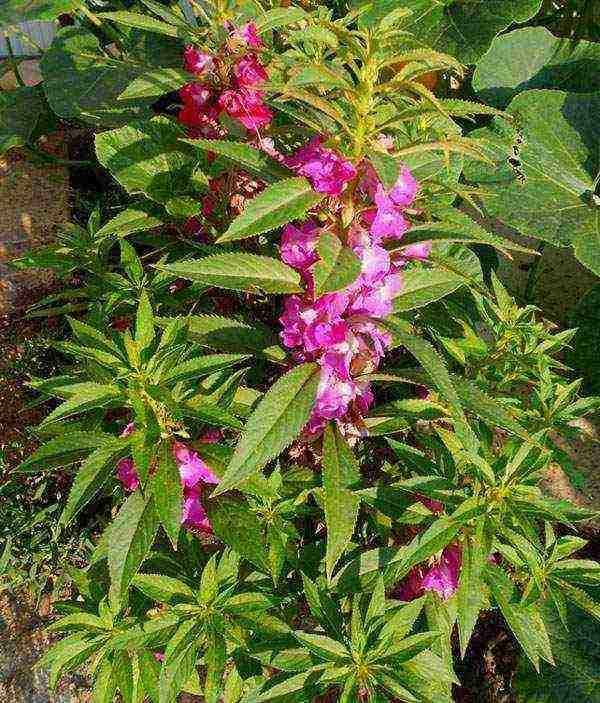 The stems of garden balsam, as in the photo, branch, which allows you to get a dense crown, strewn with flowers of all kinds of colors and shades from June to September.
The stems of garden balsam, as in the photo, branch, which allows you to get a dense crown, strewn with flowers of all kinds of colors and shades from June to September.
After flowering is complete, succulent pods with brown, rounded seeds appear on the plants. Like many other varieties of balsams in the touchy garden, the contents of the box instantly scatter several meters around, as soon as you touch the fruit, or the plants touch from a gust of wind.
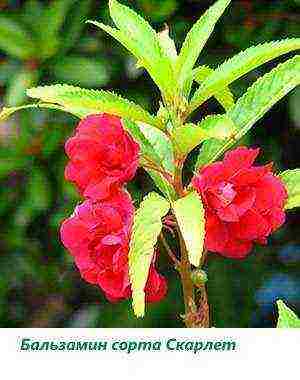 In subtropical conditions, in the homeland of culture, this feature helps balsams to quickly settle. But in the middle lane, heat-loving plants do not tolerate cold weather, therefore balsams of this type are planted in the garden only after the end of the frost period. Garden touch-me-not will also decorate the room, but additional humidification of the air will probably be required here.
In subtropical conditions, in the homeland of culture, this feature helps balsams to quickly settle. But in the middle lane, heat-loving plants do not tolerate cold weather, therefore balsams of this type are planted in the garden only after the end of the frost period. Garden touch-me-not will also decorate the room, but additional humidification of the air will probably be required here.
Garden balsam varieties are not so numerous, and most of them are of European origin and obtained for a long time. Breeders have bred plants with flowers of various colors, in shape and structure resembling garden roses, camellias and carnations.
 When choosing a variety for planting on a curb or flower bed, it should be borne in mind that garden ones can have a height of up to 70 different heights. For example, plants from the Camellia Flowered group are quite tall, and most of the flowers are concentrated in the upper part of the shoots.
When choosing a variety for planting on a curb or flower bed, it should be borne in mind that garden ones can have a height of up to 70 different heights. For example, plants from the Camellia Flowered group are quite tall, and most of the flowers are concentrated in the upper part of the shoots.
To obtain an original color spot or edging of the plantations, it is better to choose dwarf subspecies. An example is the popular Tom Thumb balsam shown in the photo.
Tom Tamb balsam plants do not exceed 25 cm, are rich in colors and long flowering. Terry flowers, replacing each other, open from June to mid-autumn, as long as the air temperature permits.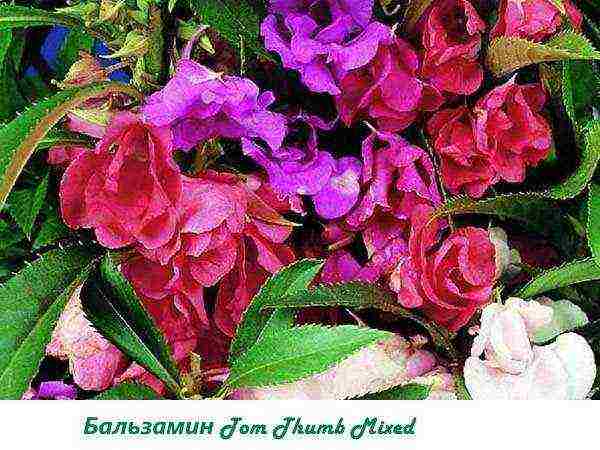
Waller's balsam (Impatiens walleriana)
Waller's balsam, the most common on Russian windows and also used for seasonal outdoor gardening, has many names. Since its discovery in the middle of the 19th century, the plant has been called Impatiens sultanii in honor of the ruler of Zanzibar, the birthplace of this decorative culture.
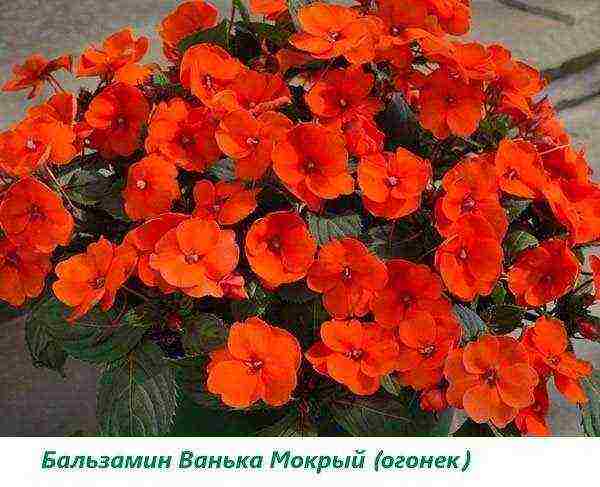 For many years, Russian flower growers are well familiar with this species under the somewhat familiar nickname of balsam Vanka Wet or under the popular name "light" for the brightness of the flowers flaming on the bush. Because of the love of water and its multicolor nature, balsam is also called “water fuchsia”.
For many years, Russian flower growers are well familiar with this species under the somewhat familiar nickname of balsam Vanka Wet or under the popular name "light" for the brightness of the flowers flaming on the bush. Because of the love of water and its multicolor nature, balsam is also called “water fuchsia”.
Unlike its garden counterpart, Waller's balsam is a perennial plant of a very small size. Under indoor conditions, the culture gives a compact branching bush up to 30–40 cm high. Under indoor conditions, the plants are higher than in the garden, and with regular pinching they bush well and do not lose their decorative effect for several years.
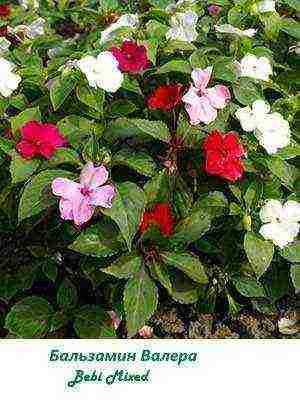 In the garden, Waller's balsams are somewhat lower; they can grow and bloom only in the summer months in the absence of harmful frosts. In the soil, the culture is planted with seedlings, and flowering begins 50–70 days after transplanting to a permanent place.
In the garden, Waller's balsams are somewhat lower; they can grow and bloom only in the summer months in the absence of harmful frosts. In the soil, the culture is planted with seedlings, and flowering begins 50–70 days after transplanting to a permanent place.
This species is distinguished by single flowers with a flattened shape and a lot of colors. Plants prefer places closed from drafts in partial shade. The sun makes the color of the flowers dimmer, and the wind can easily break the shoots that are fragile at the nodes.
Once in the hands of breeders, the culture has produced many spectacular, like a photo, popular varieties of balsam. The gamut and variety of bred flowers is simply amazing, but with all the diligence, botanists cannot get plants with flowers of yellow and blue hues. Varieties and hybrids of Waller's balsam are combined into groups of similar corollas in shape, flowering times and other external signs of plants. This is done for ease of classification and convenience for gardeners.
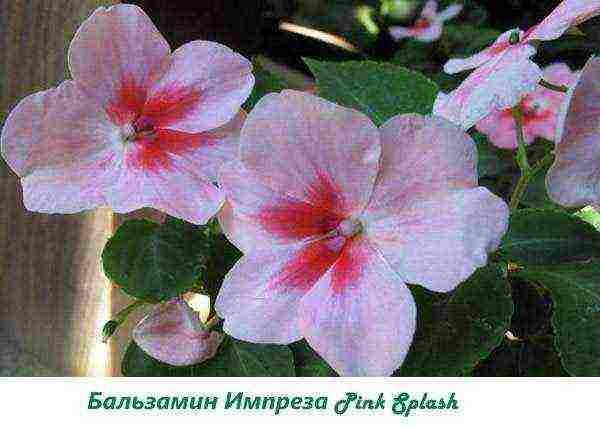 For example, the vast group of hybrid Impreza balsams are plants 15–20 cm high, with strong stems, short internodes and excellent lateral shoots. The series includes plants with raspberry, purple and carmine, simple flowers. And also specimens with original white or slightly pink corollas, decorated with a bright red spot in the center.
For example, the vast group of hybrid Impreza balsams are plants 15–20 cm high, with strong stems, short internodes and excellent lateral shoots. The series includes plants with raspberry, purple and carmine, simple flowers. And also specimens with original white or slightly pink corollas, decorated with a bright red spot in the center.
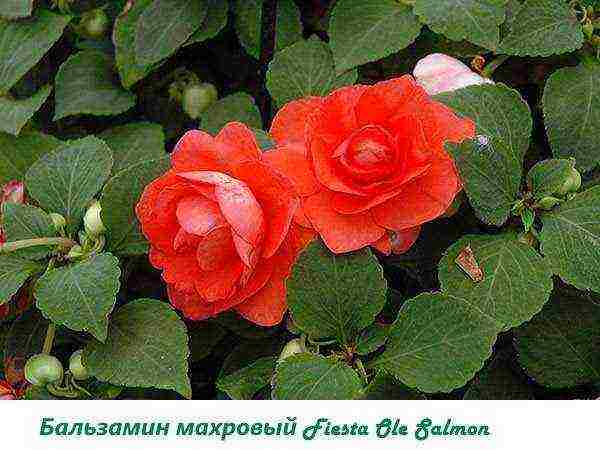 Today, the most popular varieties of balsamines with lush double flowers. Large corollas make the plant more decorative and attractive.
Today, the most popular varieties of balsamines with lush double flowers. Large corollas make the plant more decorative and attractive.
In addition to varieties with erect shoots, flower growers are offered touch-me-not ampelous balsams, which grow well in hanging baskets and pots, suitable for decorating not only interiors, but also open terraces in a country house.
In the open air, Waller's balsams bloom during the summer season, indoors the formation of buds is ongoing, but only when maintaining a relatively low temperature in the range of 16-19 ° С.
Hocker's balsam (Impatiens hawkeri)
 This type of balsam in the wild grows in New Guinea and the Solomon Islands. In appearance, it is very reminiscent of Waller's balsam, but the flowers in this case are larger, their color is richer, and the plants themselves are more hardy.
This type of balsam in the wild grows in New Guinea and the Solomon Islands. In appearance, it is very reminiscent of Waller's balsam, but the flowers in this case are larger, their color is richer, and the plants themselves are more hardy.
The wild varieties discovered in 1884 did not find wide application as ornamental plants in Europe or other countries, but became the basis for large-scale breeding work.
Balsam New Guinea (Impatiens Neuguinea)
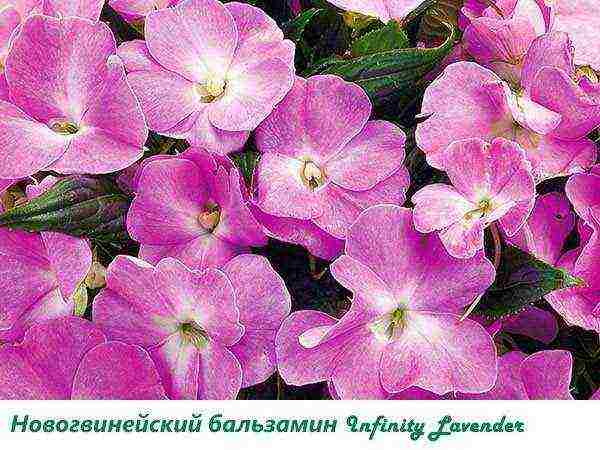 In 1972, a group of hybrid balsams was introduced to the world of flower growers, named after the homeland of their wild-growing ancestors. New Guinea balsams were bred by interspecies crossing, one hundred allowed to achieve:
In 1972, a group of hybrid balsams was introduced to the world of flower growers, named after the homeland of their wild-growing ancestors. New Guinea balsams were bred by interspecies crossing, one hundred allowed to achieve:
- high plant resistance to drought;
- larger flowers;
- expanding the range of colors;
- obtaining variegated varieties.
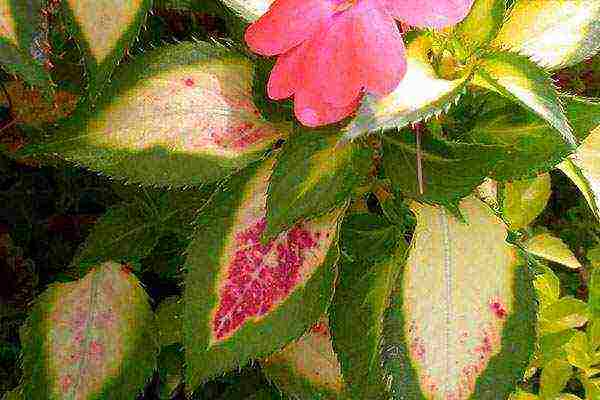 Like Waller's balsam, the new hybrid plants in the room are decorative perennials. They are distinguished by a dense, well-branching crown, large, up to 6 cm in diameter, continuously forming flowers and unpretentious care. In the open field, the culture does not tolerate winter, therefore it is grown as an annual.
Like Waller's balsam, the new hybrid plants in the room are decorative perennials. They are distinguished by a dense, well-branching crown, large, up to 6 cm in diameter, continuously forming flowers and unpretentious care. In the open field, the culture does not tolerate winter, therefore it is grown as an annual.
New Guinea balsams are leaders among related species in terms of corolla size, but form predominantly simple or semi-double flowers. Terry balsams in this case are rare.
Video about an unusual balsam plant
Balsam is an unpretentious plant that pleases the owners with abundant flowering and bright colors. The variety of shades of this flower surprises amateur flower growers who dream of having it not only in the garden, but also in their home. However, in order to ensure the cultivation of indoor balsam from seeds, it is necessary to choose only high-quality planting material and observe agricultural techniques. You also need to choose the right soil and a complex of fertilizers.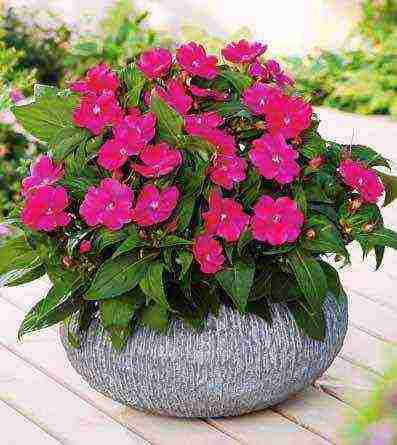
Growing balsam from seeds
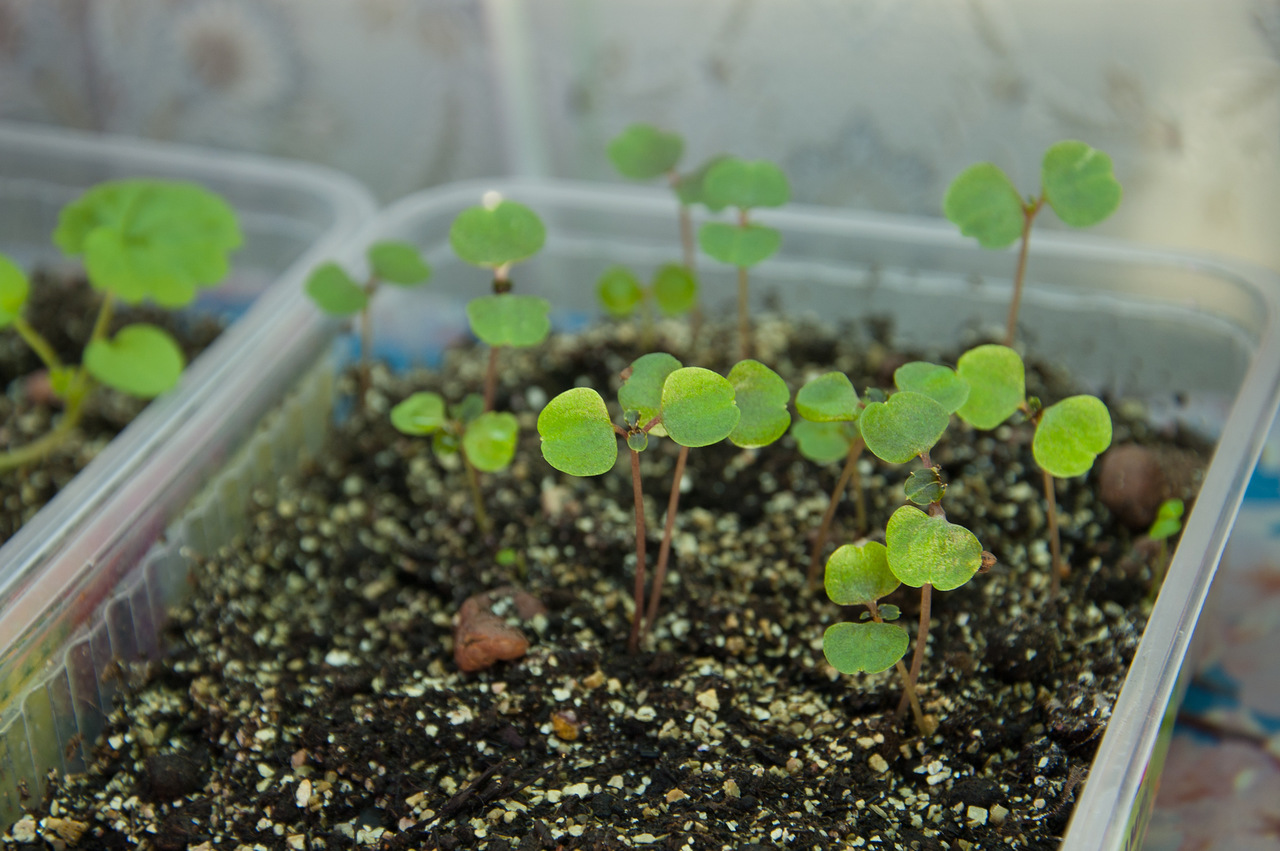 In order to properly carry out the cultivation of balsam from seeds, you need to use a wide container with a sufficient number of drainage holes. If there are seeding cassettes available, then one seed is planted in them. Young plants dive after the appearance of several leaves. For planting seeds, loose, light soil is used, in which there is no organic matter. The seeds are laid out on the surface of the soil and tamped a little, after which they are sprayed from a spray bottle. Regarding the timing, growing balsam from seeds: when to plant, it is usually in February-March, given the type of plant.
In order to properly carry out the cultivation of balsam from seeds, you need to use a wide container with a sufficient number of drainage holes. If there are seeding cassettes available, then one seed is planted in them. Young plants dive after the appearance of several leaves. For planting seeds, loose, light soil is used, in which there is no organic matter. The seeds are laid out on the surface of the soil and tamped a little, after which they are sprayed from a spray bottle. Regarding the timing, growing balsam from seeds: when to plant, it is usually in February-March, given the type of plant.
Balsam varieties for outdoor and home cultivation
There are many varieties of balsam that are grown in the open field and at home, but each type is thermophilic, therefore it requires a sufficient amount of light and heat.
The flower is distinguished by its bright color of the buds, which are double, semi-double and simple. There are dwarf, medium-sized and ampelous varieties of balsamines, which differ in growing conditions. In appearance, it is a lush, compact bush with dark green foliage, powerful shoots and large flowers with a two-color or one-color color. Such varieties are popular: garden balsam Catherine, New Zealand, Vienna waltz, Islands and those that are presented below. You can also see an article about growing pelargonium from seeds at home.
Waller's balsam
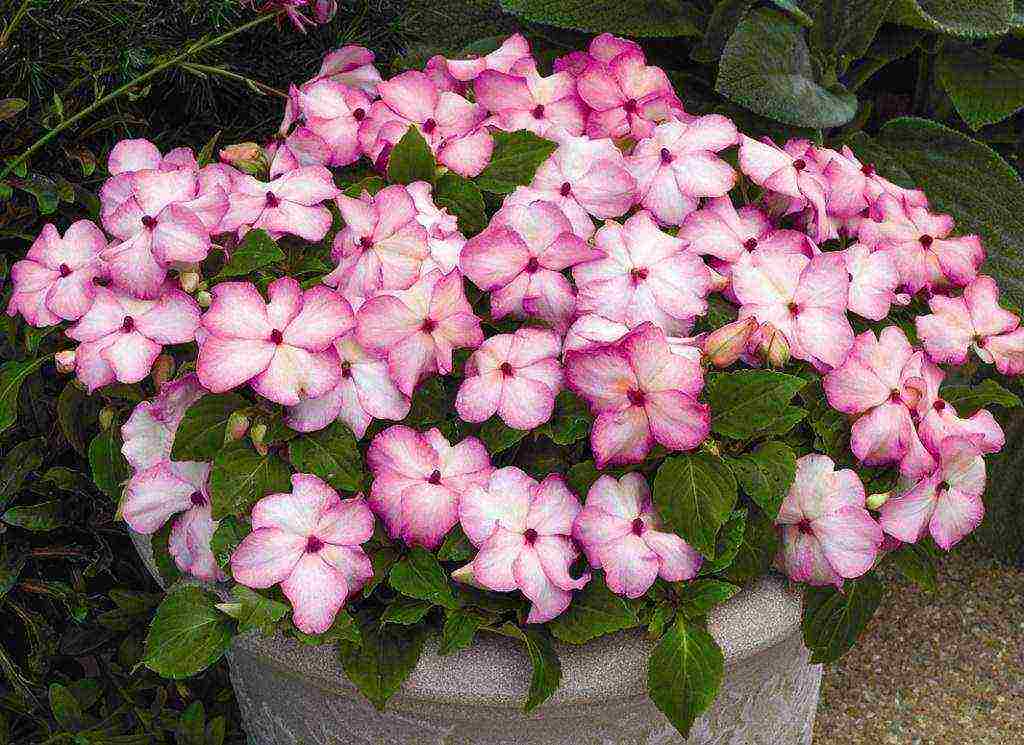 The dwarf variety of balsam Baby Waller tropical reaches a height of no more than 15-20 cm. It is distinguished by large, numerous brightly colored flowers. This species has a huge range of colors, which includes white, red, pink and lilac shades, as well as two-tone varieties. Cultivation from Waller's balsam seeds begins from the end of February to the last days of March. In spring, seedlings are planted directly in the ground or in containers for balconies.Usually, growing Baby balsam from seeds involves diving young plants that are annuals. For planting, a soil mixture of earth, peat soil and sand is used, a layer of vermiculite is spread on the bottom of the box.
The dwarf variety of balsam Baby Waller tropical reaches a height of no more than 15-20 cm. It is distinguished by large, numerous brightly colored flowers. This species has a huge range of colors, which includes white, red, pink and lilac shades, as well as two-tone varieties. Cultivation from Waller's balsam seeds begins from the end of February to the last days of March. In spring, seedlings are planted directly in the ground or in containers for balconies.Usually, growing Baby balsam from seeds involves diving young plants that are annuals. For planting, a soil mixture of earth, peat soil and sand is used, a layer of vermiculite is spread on the bottom of the box.
Balsam Tom Tamb
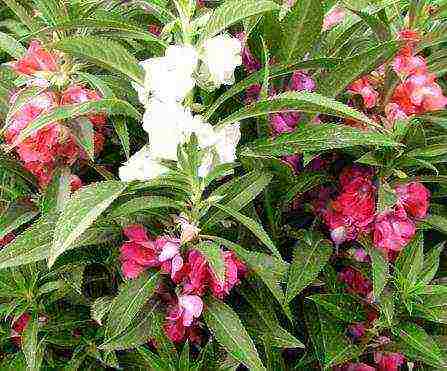 The variety belongs to the dwarf group, since it is a maximum of 45 cm in height.It has large, double flowers, camellia-shaped, and they are about 7 cm in diameter. This terry balsam is pink, white, red or lilac. It blooms within 3 months after sowing the seeds, delighting with its beauty no more than 2 months. It is grown from Tom Tamb balsam seeds by the seedling method at a temperature of at least +21 degrees. The flower is light-loving, but it can grow in the shade, where its growth slows down, and the leaves and flowers become smaller. Usually, balsam seedlings are grown from seeds for planting in containers, vases or hanging baskets. He needs regular watering and spraying in hot weather, as well as top dressing with complex fertilizers.
The variety belongs to the dwarf group, since it is a maximum of 45 cm in height.It has large, double flowers, camellia-shaped, and they are about 7 cm in diameter. This terry balsam is pink, white, red or lilac. It blooms within 3 months after sowing the seeds, delighting with its beauty no more than 2 months. It is grown from Tom Tamb balsam seeds by the seedling method at a temperature of at least +21 degrees. The flower is light-loving, but it can grow in the shade, where its growth slows down, and the leaves and flowers become smaller. Usually, balsam seedlings are grown from seeds for planting in containers, vases or hanging baskets. He needs regular watering and spraying in hot weather, as well as top dressing with complex fertilizers.
Balsam Camellia
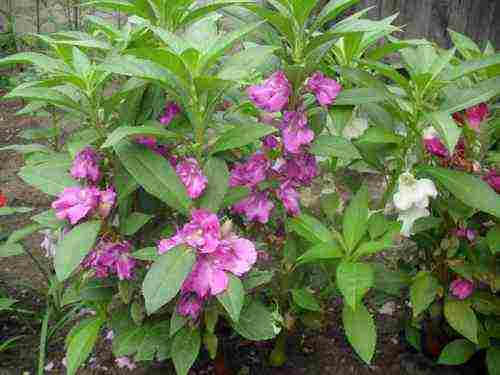 This variety is distinguished by double, bright, large flowers. The bush is no more than 50 cm high, loves warmth, therefore it cannot withstand even light frosts. Garden balsam Camellia is planted on seedlings in March or April, for which they use drained, loose soil. The seeds are laid out on the surface of the soil, sprinkled with a thin layer of soil and sprayed abundantly with water. The container is placed in a well-lit place where the temperature is at least + 20 degrees. So that the seedlings do not get sick, they are gradually taken out into the street and hardened. In early June, young seedlings are planted in open ground. Camellia balsam grows on sunny lawns, but it can also be placed in partial shade. The flower loves light, fertile soils, constant watering and regular feeding, does not tolerate waterlogging.
This variety is distinguished by double, bright, large flowers. The bush is no more than 50 cm high, loves warmth, therefore it cannot withstand even light frosts. Garden balsam Camellia is planted on seedlings in March or April, for which they use drained, loose soil. The seeds are laid out on the surface of the soil, sprinkled with a thin layer of soil and sprayed abundantly with water. The container is placed in a well-lit place where the temperature is at least + 20 degrees. So that the seedlings do not get sick, they are gradually taken out into the street and hardened. In early June, young seedlings are planted in open ground. Camellia balsam grows on sunny lawns, but it can also be placed in partial shade. The flower loves light, fertile soils, constant watering and regular feeding, does not tolerate waterlogging.
Balsam New Guinea
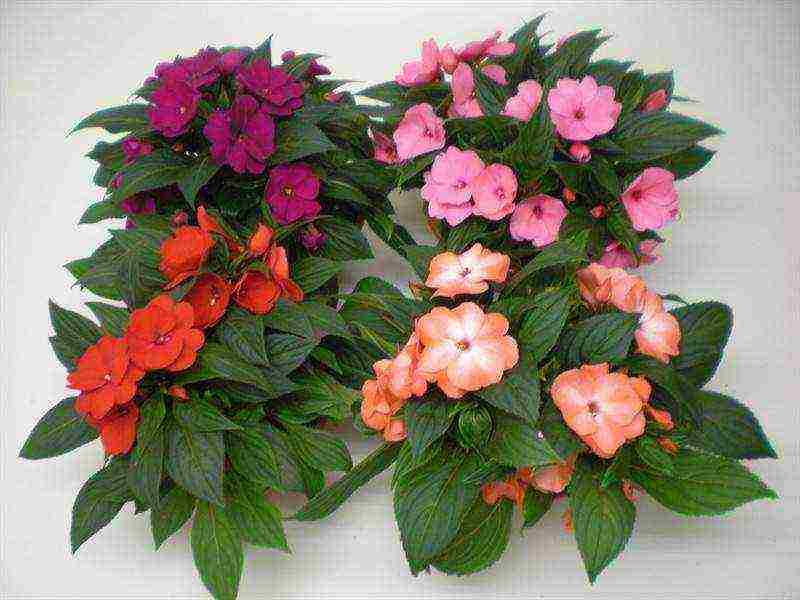 Balsam New Guinea is a perennial shrub that differs from other varieties in its growth and large, bright flowers. It should be noted that this is one of the few varieties that continues to bloom all year round. The color of flowers is also different, for example, white, purple, pink, red, yellow and other shades of buds. The leaves of the bush are bright green, dense. There are varieties of this variety in which the leaves have a yellow center, which gives the plant a more decorative look. The leaves are rather large in size than in other varieties. Since the flower is light-loving and thermophilic, cultivation from seeds of New Guinea balsam takes place indoors or in winter gardens. After a while, young seedlings are planted in open ground or containers.
Balsam New Guinea is a perennial shrub that differs from other varieties in its growth and large, bright flowers. It should be noted that this is one of the few varieties that continues to bloom all year round. The color of flowers is also different, for example, white, purple, pink, red, yellow and other shades of buds. The leaves of the bush are bright green, dense. There are varieties of this variety in which the leaves have a yellow center, which gives the plant a more decorative look. The leaves are rather large in size than in other varieties. Since the flower is light-loving and thermophilic, cultivation from seeds of New Guinea balsam takes place indoors or in winter gardens. After a while, young seedlings are planted in open ground or containers.
Balsam Safari
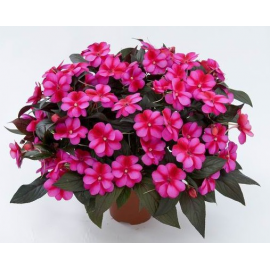 Balsamin Safari is a dwarf annual variety that blooms throughout the warm season. Its flowers are white, coral, pink, purple, red and yellow and are about 4 cm in diameter. This flower is ideal for balconies, garden pots, or grown as a houseplant. Its seeds are planted on the surface of the soil in February or March and tamped down a little. After they are sprayed with warm water. The first shoots appear in 7-10 days, after 4 weeks the seedlings dive. Balsam Safari is grown from seeds at a temperature of at least +18 degrees. Seedlings of this flower are planted already in May, when there is no threat of night frosts. When choosing a place for planting, they give preference to more sunny places. Water the seedlings regularly and abundantly, preventing the soil from drying out. To make the seedlings more bushy, the plants are pinched. It grows and blooms very well in flower pots, as it has a moderately growing root system.
Balsamin Safari is a dwarf annual variety that blooms throughout the warm season. Its flowers are white, coral, pink, purple, red and yellow and are about 4 cm in diameter. This flower is ideal for balconies, garden pots, or grown as a houseplant. Its seeds are planted on the surface of the soil in February or March and tamped down a little. After they are sprayed with warm water. The first shoots appear in 7-10 days, after 4 weeks the seedlings dive. Balsam Safari is grown from seeds at a temperature of at least +18 degrees. Seedlings of this flower are planted already in May, when there is no threat of night frosts. When choosing a place for planting, they give preference to more sunny places. Water the seedlings regularly and abundantly, preventing the soil from drying out. To make the seedlings more bushy, the plants are pinched. It grows and blooms very well in flower pots, as it has a moderately growing root system.
Balsam Cutie
 A beautiful, compact bush with dense foliage, it reaches a height of no more than 20 cm. Its flowering is abundant, in the form of beautiful, white flowers. It is used for planting on balconies, window sills, on tangles.Since the balsam Milashka belongs to the group of light-loving ones, it grows well on sunny lawns, but maybe in partial shade, where there is fertile, loose soil. Differs in abundant flowering, tolerates haircuts. For seedlings, seeds are planted in boxes and sprinkled with a thin layer of earth. In order for the cultivation of balsam from seeds and care to give a good result, the plant needs to be provided with abundant watering, feeding and a temperature of at least +18 degrees.
A beautiful, compact bush with dense foliage, it reaches a height of no more than 20 cm. Its flowering is abundant, in the form of beautiful, white flowers. It is used for planting on balconies, window sills, on tangles.Since the balsam Milashka belongs to the group of light-loving ones, it grows well on sunny lawns, but maybe in partial shade, where there is fertile, loose soil. Differs in abundant flowering, tolerates haircuts. For seedlings, seeds are planted in boxes and sprinkled with a thin layer of earth. In order for the cultivation of balsam from seeds and care to give a good result, the plant needs to be provided with abundant watering, feeding and a temperature of at least +18 degrees.
Balsam Strawberry with cream
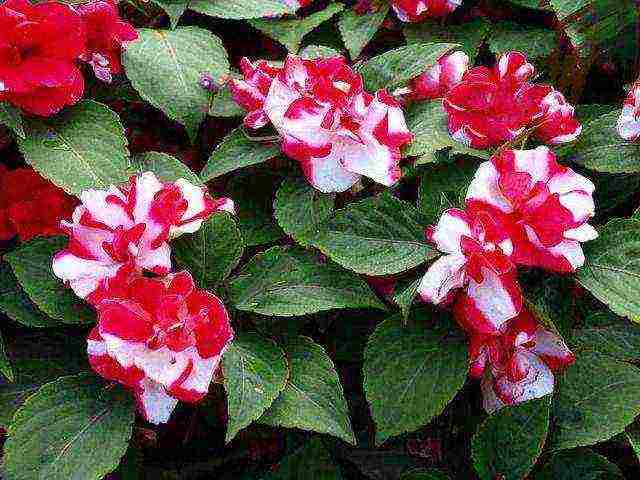 This balsam is grown for planting on terraces, balconies, containers or for outdoor use. Since the plant is thermophilic, it is able to overwinter only at a sufficient temperature of warmth, therefore it is often used as an indoor flower. In appearance, Strawberry Cream Balsam is a compact, branched shrub that first blooms in June and continues until the end of August. For seedlings, seeds are sown in March at a temperature of about +22 degrees, covering the boxes with foil. When three leaves appear on the seedlings, it can be dived.
This balsam is grown for planting on terraces, balconies, containers or for outdoor use. Since the plant is thermophilic, it is able to overwinter only at a sufficient temperature of warmth, therefore it is often used as an indoor flower. In appearance, Strawberry Cream Balsam is a compact, branched shrub that first blooms in June and continues until the end of August. For seedlings, seeds are sown in March at a temperature of about +22 degrees, covering the boxes with foil. When three leaves appear on the seedlings, it can be dived.
Balsam dwarf Exotic
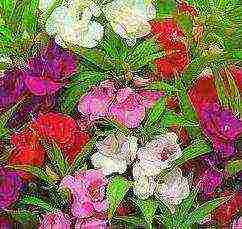 The variety belongs to the group of the lowest, therefore, the balsam is about 18-20 cm high. Usually it is used for planting on a balcony, terrace, choosing the north-west or north-east side. According to the conditions of detention, dwarf balsam Exotic is unpretentious, since it can grow in insufficient lighting, having an active flowering. It is a compact plant with very bright flowers up to 4 cm in diameter and lanceolate leaves. The color of the buds is purple, pink or lilac. The flower grows on fertile soils. Its bloom begins in March and lasts the entire warm season.
The variety belongs to the group of the lowest, therefore, the balsam is about 18-20 cm high. Usually it is used for planting on a balcony, terrace, choosing the north-west or north-east side. According to the conditions of detention, dwarf balsam Exotic is unpretentious, since it can grow in insufficient lighting, having an active flowering. It is a compact plant with very bright flowers up to 4 cm in diameter and lanceolate leaves. The color of the buds is purple, pink or lilac. The flower grows on fertile soils. Its bloom begins in March and lasts the entire warm season.
Balsam Kandy
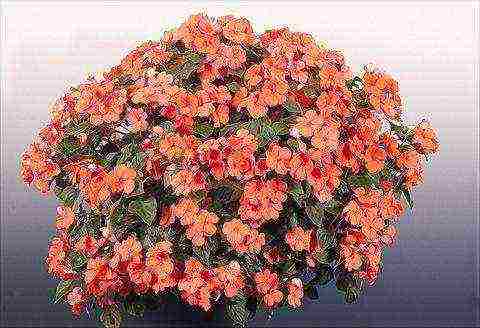 The plant is compact in shape, very branched and blooms profusely, so it looks great in single plantings. In terms of color, Kandy balsam is quite diverse. It can have red, pink, lilac and purple shades of flowers, and there are also two-color varieties that are distinguished by bright shades. The flower blooms very early and pleases with its decorative buds until late autumn. Its seeds are planted on seedlings in early spring, using boxes or boxes for this. From above, the container is covered with a film or glass, which must be periodically opened for ventilation. After 1-2 weeks, the first shoots will appear, which dive after the formation of several leaves.
The plant is compact in shape, very branched and blooms profusely, so it looks great in single plantings. In terms of color, Kandy balsam is quite diverse. It can have red, pink, lilac and purple shades of flowers, and there are also two-color varieties that are distinguished by bright shades. The flower blooms very early and pleases with its decorative buds until late autumn. Its seeds are planted on seedlings in early spring, using boxes or boxes for this. From above, the container is covered with a film or glass, which must be periodically opened for ventilation. After 1-2 weeks, the first shoots will appear, which dive after the formation of several leaves.
Balsam Carmelita
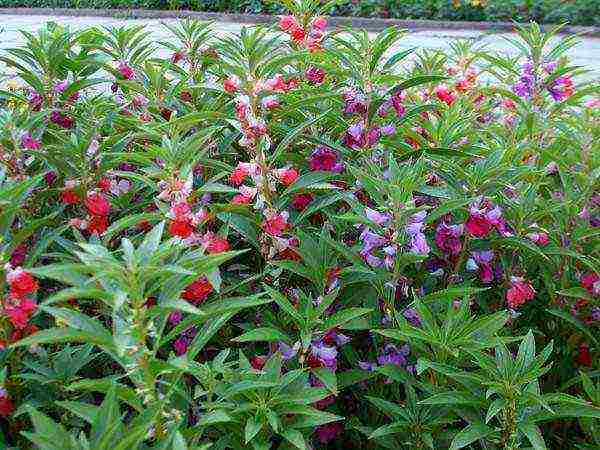 This annual variety is a rather tall plant, as it can reach a height of up to 70 cm, Carmelita garden balsam has a pyramidal shape and will be a wonderful decoration for any garden. The plant is thermophilic, moisture-loving and shade-tolerant, its stems are fleshy, so they can break at the nodes. Garden balsam Carmelita blooms in large, double flowers up to 4 cm in diameter, which have a camellia-like shape. Their color is different - from white to dark purple. Flowering begins in June and lasts until September. The flower is very thermophilic, therefore it reacts to the slightest drop in temperature. Its seeds are sown in May or April, and seedlings are planted in May or early June. The distance between the bushes should be at least 20 cm.
This annual variety is a rather tall plant, as it can reach a height of up to 70 cm, Carmelita garden balsam has a pyramidal shape and will be a wonderful decoration for any garden. The plant is thermophilic, moisture-loving and shade-tolerant, its stems are fleshy, so they can break at the nodes. Garden balsam Carmelita blooms in large, double flowers up to 4 cm in diameter, which have a camellia-like shape. Their color is different - from white to dark purple. Flowering begins in June and lasts until September. The flower is very thermophilic, therefore it reacts to the slightest drop in temperature. Its seeds are sown in May or April, and seedlings are planted in May or early June. The distance between the bushes should be at least 20 cm.
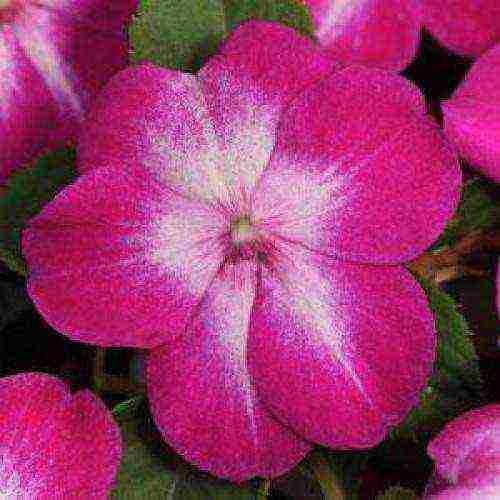 Balsam Super Elfin
Balsam Super Elfin
A smartly handsome man who came from the well-known flower "Roly Wet". It has a compact size, strong branches that reach a height of 25 cm, so the Super Elfin balsam belongs to the dwarf group. The bush is about 35 cm wide, its flowering is long and abundant. In terms of color, this annual balsam has rich, bright flowers with a distinctive speck in the center. For seedlings, seeds are sown at the end of February or March, choosing sunny places or partial shade. The distance between young seedlings for seedlings should be about 15 cm. Balsam blooms from June to October.
Balsam Eurasia
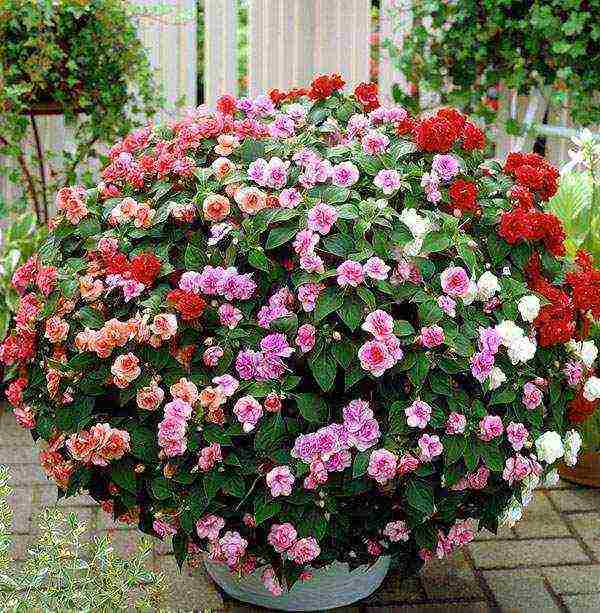 The variety belongs to the group of annual plants, differs in a spherical shape of bushes, which are up to 15 cm in diameter. Its flowers are large in diameter up to 6 cm, differ in bright shades - cream, red, carmine or pale pink. Balsam Eurasia blooms from June to the first frost. The flower is often planted on balconies, baskets or flower beds. Grows well in sunny meadows, but withstands partial shade. For planting seedlings, it is better to choose fertile, loose soil, where there will be enough moisture and heat, and cannot tolerate waterlogging of the soil. Seed propagation takes place in March or April using seedling boxes. From above, the seeds are sprinkled with sand in a layer of 3 mm, and then sprayed with warm water. Next, the boxes are covered with glass and placed in a warm, lighted place. After 14-19 days, the first shoots will appear, which dive after the appearance of the first leaves. Young seedlings are planted in open ground or on a balcony in mid-May. If desired, the flower is grown in the house.
The variety belongs to the group of annual plants, differs in a spherical shape of bushes, which are up to 15 cm in diameter. Its flowers are large in diameter up to 6 cm, differ in bright shades - cream, red, carmine or pale pink. Balsam Eurasia blooms from June to the first frost. The flower is often planted on balconies, baskets or flower beds. Grows well in sunny meadows, but withstands partial shade. For planting seedlings, it is better to choose fertile, loose soil, where there will be enough moisture and heat, and cannot tolerate waterlogging of the soil. Seed propagation takes place in March or April using seedling boxes. From above, the seeds are sprinkled with sand in a layer of 3 mm, and then sprayed with warm water. Next, the boxes are covered with glass and placed in a warm, lighted place. After 14-19 days, the first shoots will appear, which dive after the appearance of the first leaves. Young seedlings are planted in open ground or on a balcony in mid-May. If desired, the flower is grown in the house.
Balsamin Bambina
Ideal for northeast or northwest balconies.
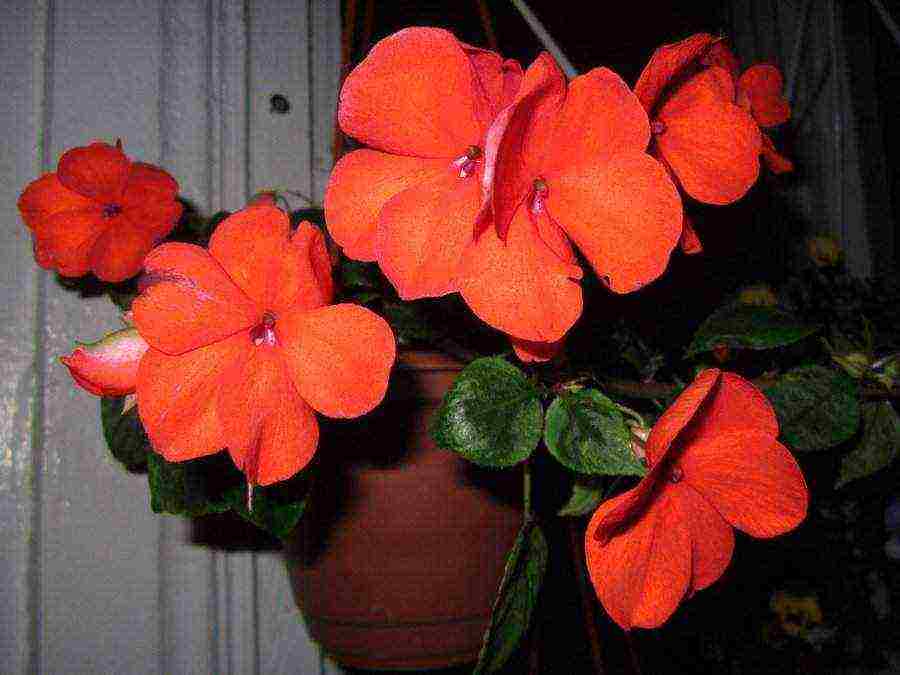 Its color range is huge and includes more than a dozen colors. In appearance, Bambin's balsam has a spherical shape and reaches a height of about 25 cm. Its leaves are dark green, the flowers are large and have different colors. Flowering begins in June and lasts until frost. This flower can grow in hanging vases, containers or boxes on balconies. It is unpretentious, shade-tolerant and moisture-loving, loves fertile soil, where there is no stagnation of water. In mid-May, the balsam can be displayed on the balcony or in the garden. Differs in abundant flowering, which requires pinching.
Its color range is huge and includes more than a dozen colors. In appearance, Bambin's balsam has a spherical shape and reaches a height of about 25 cm. Its leaves are dark green, the flowers are large and have different colors. Flowering begins in June and lasts until frost. This flower can grow in hanging vases, containers or boxes on balconies. It is unpretentious, shade-tolerant and moisture-loving, loves fertile soil, where there is no stagnation of water. In mid-May, the balsam can be displayed on the balcony or in the garden. Differs in abundant flowering, which requires pinching.
Balsam Boy with a finger
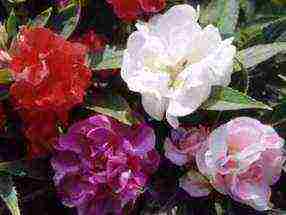 A beautiful, abundantly flowering plant that is compact in size, highly branched stems and bright, double large flowers. It can be grown as an indoor flower or outdoors. Seeds are planted on the surface of the soil in late February or early April. At a temperature of at least +18 degrees, the first shoots appear, which dive in 4 weeks. On a permanent place balsam Boy with a finger can be planted in May, when there is no threat of spring frosts. This variety loves sunny places, but is able to tolerate partial shade and even shade, where its branches and flowers will be smaller. The flower prefers abundant watering, as it does not tolerate drying out of the soil. To make the bush more branched, its tops need to be pinched. Balsam can grow in cramped pots and outdoors, where it will be large.
A beautiful, abundantly flowering plant that is compact in size, highly branched stems and bright, double large flowers. It can be grown as an indoor flower or outdoors. Seeds are planted on the surface of the soil in late February or early April. At a temperature of at least +18 degrees, the first shoots appear, which dive in 4 weeks. On a permanent place balsam Boy with a finger can be planted in May, when there is no threat of spring frosts. This variety loves sunny places, but is able to tolerate partial shade and even shade, where its branches and flowers will be smaller. The flower prefers abundant watering, as it does not tolerate drying out of the soil. To make the bush more branched, its tops need to be pinched. Balsam can grow in cramped pots and outdoors, where it will be large.
Balsam Impreza
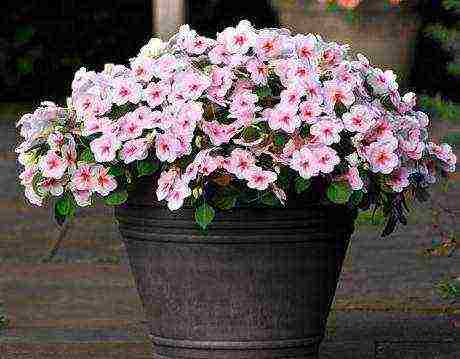 The plant is used for planting in balcony boxes or hanging baskets. The variety looks like a bush with dense foliage and reaches a height of up to 20 cm. Its flowers are pale pink, have specks on the lower petals. Balsam Impreza blooms profusely and with bright, multi-colored flowers, it is used for planting in hanging baskets, on balconies or terraces. The plant loves warmth and light, can grow in partial shade, prefers fertile soil. In order for its flowering to be more abundant, it needs a haircut. Its seeds are scattered on top of the soil and sprinkled with fine-grained sand, sprinkling with water. The temperature for planting seeds should be at least +18 degrees, the first shoots appear after 15 days. Seedlings are planted in the ground after the threat of spring frosts; a distance of about 20 cm is maintained between the bushes.
The plant is used for planting in balcony boxes or hanging baskets. The variety looks like a bush with dense foliage and reaches a height of up to 20 cm. Its flowers are pale pink, have specks on the lower petals. Balsam Impreza blooms profusely and with bright, multi-colored flowers, it is used for planting in hanging baskets, on balconies or terraces. The plant loves warmth and light, can grow in partial shade, prefers fertile soil. In order for its flowering to be more abundant, it needs a haircut. Its seeds are scattered on top of the soil and sprinkled with fine-grained sand, sprinkling with water. The temperature for planting seeds should be at least +18 degrees, the first shoots appear after 15 days. Seedlings are planted in the ground after the threat of spring frosts; a distance of about 20 cm is maintained between the bushes.
Balsam Acrobat
Unique ampelous balsam, which is grown from seeds. In appearance, it is spectacular, bright, with beautiful red flowers. The plant branches quickly and forms a cascade, reaching up to 40 cm in length. The balsam Acrobat blooms in large flowers, which are up to 5 cm in diameter. It is planted on seedlings, like other varieties of this flower.
Balsam Lollipop
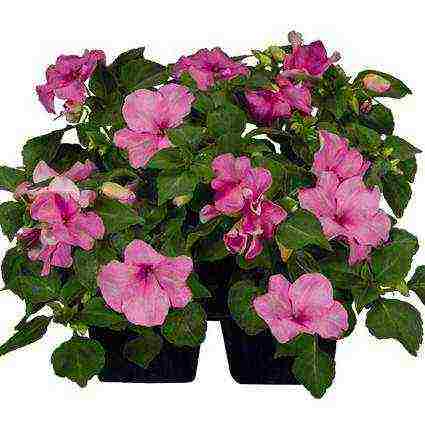 A brilliant, unusual, ampelous balsam, which gives many branches, a bush in diameter can reach up to 40 cm.Lollipop balsam blooms profusely and for a long time, its flowers are large, open, up to 5 cm in diameter. The people call this flower the Violet Star, as it is distinguished by its cherry-purple color, shining like real stars. Its thin, wavy petals stand out for their original look. Seeds are planted on seedlings in March, and seedlings are planted in open ground at the end of May. We also recommend viewing the article: Tree peony - care and cultivation of a flower crop from seeds.
A brilliant, unusual, ampelous balsam, which gives many branches, a bush in diameter can reach up to 40 cm.Lollipop balsam blooms profusely and for a long time, its flowers are large, open, up to 5 cm in diameter. The people call this flower the Violet Star, as it is distinguished by its cherry-purple color, shining like real stars. Its thin, wavy petals stand out for their original look. Seeds are planted on seedlings in March, and seedlings are planted in open ground at the end of May. We also recommend viewing the article: Tree peony - care and cultivation of a flower crop from seeds.
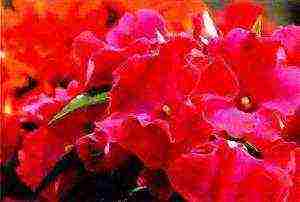
In Russia, the people call the plant "Vanka wet". It can be assumed that they called him that for two reasons: "Vanka" is the most common and familiar name, and "wet" is due to the fact that the stems of the plant are very watery and, when damaged, release "sweet tears".
Water droplets stand out (guttation) on the sharp tips and serrated edges of the leaves in inclement weather, with the approach of a thunderstorm, during fog, and with abundant watering, the plant becomes really wet.
Without consulting the Russians, the British also awarded this plant with a human name. But they saw in the flower not the masculine, but the feminine principle, and gave the name "Liza". Quality is also indicated - "busy": "Liza" is always passionate about flowering - a real hard worker.
The Austrians call balsam a "beautiful wreath", comparing a flowering plant with a beautiful girl. In Ukraine, it is called the "spark" - for the bright color of the flowers.
Balsam is a botanical genus that includes more than 850 species, of which only 15 are cultivated. The homeland of balsams is the subtropics and tropics of Asia and Africa, Southern Europe and North America. Of the annual balsams, garden balsam is the most widespread among flower growers.
Popular species and varieties
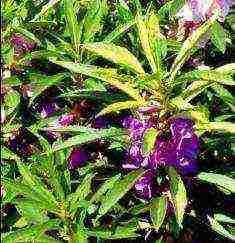
Garden balsam
Garden balsam, or balsam balsam erect plant of pyramidal or spherical shape, up to 70 cm high. Stems are branched, smooth, fleshy, green, easily break at the nodes. Lateral branches are soft, with a reddish bloom.
The leaves are petiolate, lanceolate, pointed, serrated along the edge, arranged in the next order. The plant is densely leafy. The flowers are large, irregular, sessile, axillary, simple or double, from white to purple in color.
Blooms in June-September. The fruit is a capsule with brownish-brown spherical seeds. 1 g contains 90-100 seeds, the germination of which lasts for 6-8 years. Homeland-India, Malaysia, South China.
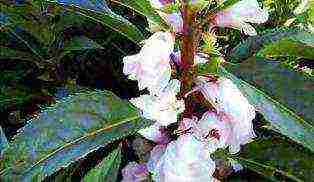
Garden balsam
For unknown reasons, this species is practically not of interest to breeders, it has very few varieties, and all were bred in Europe (tall and short). Terry varieties are good in the borders and in the center of the flower bed.
Among the new products are unusual undersized varieties that resemble Waller's (Waller's) balsam: they do not have a long main stem. These are compact, densely branching bushes, up to 35 cm tall. The 'Carambole' series includes 4 varieties with scarlet, creamy pink, deep lilac and white flowers.
Balsam Waller, or Sultan's balsam - a perennial, grown as an annual, with abundantly branched, succulent translucent shoots, forming compact bushes about 25 cm high. Flowers about 4 cm in diameter, single or in few-flowered inflorescences with long pedicels.
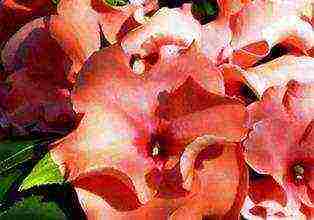
Balsam Waller "Bruno Pink"
For the bright color of rather large flowers (red, purple, blue, lilac, pink and white), the plant is universally called "fire". It blooms in 90 - 100 days after germination. Seed germination lasts 6-8 years.
Balsam of this type is suitable both for an apartment and for flower beds. Plants are planted in containers and hanging baskets. Outdoors, Waller's balsam can be placed even in a fairly dense partial shade due to its undemanding lighting.In such conditions, the color of flowers is usually brighter than in the sun.
Moisture-saturated stems and leaves of plants are characterized by increased fragility. They break easily in sudden gusts of wind and heavy rain. It is undesirable to plant this species on balconies and other places where it is often windy.
Waller's balsam is now so popular that new varieties and hybrids are constantly appearing. Most often, varieties are combined in series, characterized by a certain color range, or height, or flower shape, which can be simple, double and semi-double.
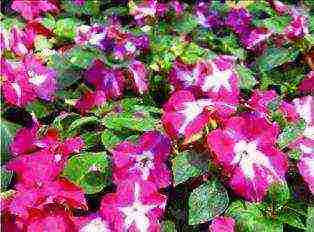
Balsam Carmen "Cherry Star"
The first terry balsam was 'Teak-tock' with pink or dark red flowers. Modern series include up to 17-20 different shades of white, red, pink and purple, there are also varieties with a two-tone color. Until they created balsams only with a blue and yellow color of the corolla.
Currently, mainly heterotic F1 hybrids are offered, characterized by abundant flowering and large flowers up to 5 cm in diameter. The varieties with brown-red leaves and orange-red large flowers similar to roses, camellias and carnations are very effective. In short, the choice is wide enough.
In culture, there are varieties with two-colored flowers with white stripes or centers (‘Cinderella’, ‘Novetta Star’, ‘Zig-Zag’, ‘Sparkles’, ‘Rose Star’). Terry forms are less popular, but ‘Rosette’, ‘Double Duet’ and ‘Confection’ can be tried for variety.
At the peak of popularity now and New Guinean hybrids... They were bred by complex crosses of 3 types of balsam: B. Hacker, B. linear-leaved and B. Schleiger. As ornamental plants, these hybrids began to be used in 1972.
Since then, plants have gained widespread popularity due to their beauty and endurance when cultivated indoors and in flower beds. Although representatives of this group are perennials, they are grown as annuals in hot and temperate climatic zones.
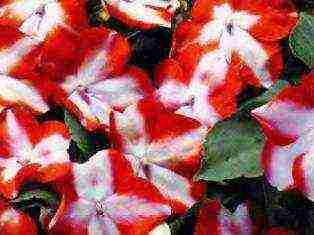
Balsam Carmen "Orange Star"
New Guinean hybrids appeared on the domestic market relatively recently and immediately became popular. These spectacular plants reach a height of 30-60 cm, the shoots do not stretch, the flowers are large, although they usually bloom only in summer.
Many varieties have been bred that are propagated exclusively by cuttings, since few seeds are formed. Plants with dark red, purple, cherry blossoms are more tenacious and less sick. Their leaves are almost always colored (red, bronze, yellow-green, yellow-green-red), surpassing the leaves of Waller's balsam in size.
The flowers are large (6-9 cm in diameter), bloom throughout the year, of different colors: white, red, various shades, lilac, pink. They are good in containers together with ampel decorative leafy plants.
New Guinean hybrids are more warm and light-loving, so it is better to grow them in rooms and conservatories, but they also look great in flowerpots installed in sunny, wind-protected corners of the garden or on warm terraces.
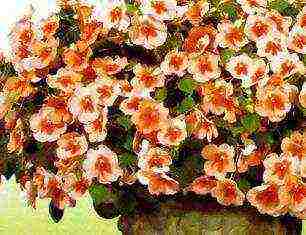
Balsam Carmen "Peach Butterfly"
They require systematic watering and feeding, prefer peat substrate. To get flowering by mid-May, professionals sow their seeds in January-February. Seedlings need bright and long-term illumination and warmth.
Let's name some varieties: 'Tango' (bronze foliage, orange flowers), 'Fanfare' (yellow-green leaves, pink flowers), 'Arabesque' (yellow-green-red leaves, pink flowers), 'Temro Blash' (white- pink flowers with a pink eye), 'Java' (bright flowers against a background of shiny green or bronze leaves), 'Jangle Rain' (with pastel flowers), 'Macarena' (with luminescent orange corolla and bronze-green leaves).
Now the 'Harmony' series is very popular, which is characterized by large compactness, intense branching and large round flowers, contrasting with green, red, bronze foliage. The 'Mini Gini' series features numerous small flowers that cover the plant abundantly throughout the year. The leaves are dark green. The varieties of these balsams are taller than the long-known varieties of Waller's balsam.
Other types of balsams are less common, but deserve attention and respect: Niamey balsam, creeping balsam, Balfour balsam, linear-leaved balsam, forest balsam, Royle's balsam, tuberous balsam, iron-bearing balsam, Holst's balsam. Peters' balsam is grown from perennial species in indoor conditions.
Highlights of grooming and reproduction
Location... Balsams grow well and bloom profusely in partial shade or in open sunny places, especially when shaded from 12:00 to 15:00. Plants cannot stand the scorching rays of the sun, so they need shading on the southern windows.
They are surprisingly easy to adapt to any type of lighting. Balsam blooms beautifully under trees with a loose crown and near the house from the north-west or north-east side.
Peculiarities... The plant is very thermophilic, even at a temperature of + 5 ° C it stops growing and starts to hurt. The ideal temperature is from + 15-16 ° C to + 25-28 ° C. When grown at home, in summer, balsams are watered abundantly and often (2-3 times a week), but not poured, since the plants are sensitive to excess water in the soil. Moderate watering should be provided during winter.
In the rooms, balsams bloom for 6-8 months, sometimes all year round. The plant blooms better in a small pot. An interesting nuance - balsams do not tolerate tobacco smoke.
The soil... Balsams require light, fertile soils. They do not grow on heavy and cold lands.
Care... The plant is fast-growing and abundant flowering, so it needs additional feeding. Balsam leaves need regular spraying, otherwise a tick will settle on them.
They are planted in pots commensurate with the root system, filled with loose nutrient soil. In the summer, they are fed every 10-15 days with mullein infusion (1:10) or a 2% solution of complete mineral fertilizer.

garden balsam
Repeatedly during the summer, pinch the shoots for the splendor of the plant. Balsams bloom until the frost. The bare stems are pruned and the rooted cuttings are planted in pots. The soil mixture should be loose and nutritious, consisting mainly of humus, deciduous soil, with the addition of sand.
In winter, they are kept at + 12-16 ° C, watered less often, but regularly, since balsams do not stop growing during this period. Plants shed their leaves from high temperature and lack of light. In the second half of May, balsams can be taken out on the balcony or in the garden.
Remember: balsam does not like tightness, when in contact with other plants, the leaves and flowers of "touchy" fall off, the ends of the stems break off. It is best to place the flower pot in a free, sunny place.
Transfer... It is advisable to transplant balsam annually in spring, while it is not necessary to take a larger pot, it is enough to completely replace the soil, because balsam blooms only in a cramped pot. From 3 years of age or earlier, balsams should be replaced with young plants grown from cuttings, since old bushes lose their decorative effect - they form few leaves and bloom poorly.
Reproduction... Balsams are propagated by cuttings and seeds. In spring and summer, cut stems up to 10 cm long, rooted in water or wet sand. It can also be propagated by apical herbaceous cuttings throughout the year, cutting cuttings from the mother plants. Cuttings take root after 14-16 days, and after 2-3 months, young plants bloom.
Seeds are sown in February-March in greenhouses and hotbeds, embedded in the soil superficially, since light is needed for germination. The optimum temperature is + 20-25 ° С. The seeds are sensitive to a lack of moisture, so the boxes with crops are covered with glass or transparent plastic and placed in a well-lit place, but without direct sunlight.
Seedlings appear within 10-15 days. After emergence, the moisture content of the substrate and air must be reduced.Greenhouses and nursery boxes should be ventilated as often as possible to reduce the risk of developing fungal infections. They usually dive one plant at a time in pots with a diameter of 7-9 cm. They are planted in the ground after the end of spring frosts.
The use of balsam in landscaping
Balsams are unsurpassed plants for semi-shaded areas. They are planted in flower beds, boxes on balconies, pots on windows, street vases and containers installed in squares, in gardens, parks, in front of the entrance to buildings, as well as for decorating lobbies of cinemas, industrial and public premises, shop windows, etc. ... The main condition for successful growth is that the soil in containers must be constantly moist.
Vertical flower beds were not widely used in garden design until Waller's balsam came into fashion. It was he who made us take a fresh look at the possibilities of vertical gardening not only with the help of vines, but also with the use of bright flowering balsam bushes.
A screen of balsams is made in this way: they take 4 strong pegs and drive them into the ground by a third. Then a plastic coarse mesh is connected with black lutrasil and fixed with a black film inward on pegs. The resulting container is filled with earth. During backfilling, two irrigation tubes are inserted inside. The vertical screen is ready.
In lutrasil, you need to make cuts and plant blooming balsam bushes there. Over time, the plants will close together and you will have a bright screen. Experienced flower growers, in the presence of multi-colored varieties, create whole pictures that will decorate the shady corners of the garden all summer.
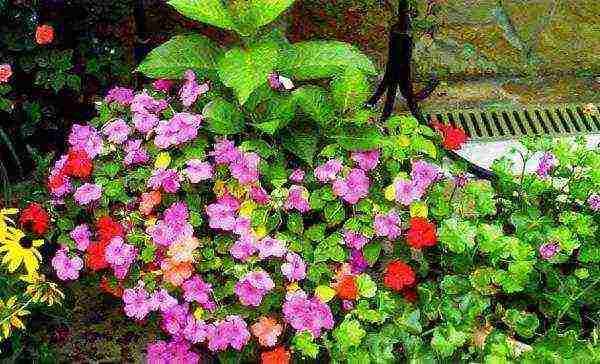
Svetlana Mashkovskaya

Terry varieties of indoor balsam are especially loved by flower growers - unlike ordinary plants, their flowers resemble small roses.
Indoor balsam: photo and description of flowers
The genus Balsamin has over 500 species of annual and perennial herbaceous plants of the balsam family. Its homeland is the tropics and sub-tropics of Asia and Africa, some species are found in Central Asia.
As a houseplant it has been known for a very long time and is invariably popular. Probably the most popular plant in the world. These flowers were first introduced to Europe in 1596. Due to its unpretentiousness, year-round flowering and ease of reproduction, this cute plant has been loved for more than four hundred years. Many of its popular names are known: touch-me-not, light, Vanka wet, ever-flowering.
Stems are juicy, branched, with a height of 15 to 50 cm in different varieties. Leaves are green, reddish-green or bronze, wavy at the edges, fleshy. With an increase in humidity, droplets of liquid appear at the tips of the leaves, for which the plant is called Vanka-wet.
As you can see in the photo, in indoor balsam, flowers are located in the axils of the leaves:
They are white, pink, orange, red, purple, and also with stripes or specks. Hybrids with double flowers and multi-colored leaves were bred. The flowers are small, but very bright, reminiscent of lights, hence the name "light".
With proper planting and caring for indoor balsam, after flowering, the plant produces green fruits, which, after ripening, form a dry box with seeds. Even with a light touch, it "explodes" and scatters seeds. The popular name "touchy" apparently stuck precisely because of this feature of the plant.
Look at the photo - balsam indoor flowers bloom very abundantly almost all year round:
Grown as an annual plant for balconies and gardens, as well as a perennial unpretentious houseplant.
Intensive selection work has made it possible to breed many hybrids and varieties of indoor balsam, differing in height, flower color and size, and leaf color.
Below is a description, photo and video of balsamic care at home, as well as advice on growing plants from seeds.
Growing indoor balsam from seeds
Before growing indoor balsam from seeds, they should be placed in a weak solution of potassium permanganate for 10 minutes, and then soaked in warm water for a day. Next, you should start preparing the land for planting. Seedlings are very sensitive to the composition of the soil, which should be loose and slightly acidic. A self-prepared mixture of equal parts of the following components is well suited for this: peat soil (2 parts); sheet land (1 part); vermiculite (1 part); river coarse sand (1 part). You can take ready-made soil for seedlings. But it is imperative to add one fifth of vermiculite or sand to it, which will make the soil loose and breathable. This will give the earth the opportunity to dry out faster, and weak seedlings will not die from excessive moisture.
To grow indoor balsam from seeds, a seedling container should be chosen about 7 cm in height or slightly larger. To do this, you can take a plastic container, a wide bowl or pot. It is necessary to make holes in the bottom of the container and provide it with a layer of expanded clay 2 cm thick. Such a precaution will not allow water to linger in the soil and save the seedlings from root rot. On the eve of sowing, you need to fill the container with earth and spill it with the "Fitosporin" solution, which improves the microflora of the soil and protects against such a serious problem as the "black leg".
Pour fertile soil into a container for seedlings, moisten and compact it. Place the seeds at a distance of 2 cm from each other and sprinkle lightly with earth. Cover the planting with a plastic bag on top and put it in a bright place. If you want the seeds to sprout faster, illuminate the seedlings with a lamp.
A warm place and good lighting are essential for successful germination. However, the seedlings should be protected from direct sunlight. The optimum temperature for seed germination is from +22 to +25 ° C.
After about 3 weeks, the first shoots appear. During this time, it is important to adhere to the following actions: As often as possible, ventilate the crops and shake off the accumulated condensate from the "greenhouse" in order to protect the seeds from air stagnation and fungal infection. Moisten the soil from a spray bottle, avoiding both overdrying and waterlogging of the soil. Supplement the seedlings with a phytolamp in the morning, in the evening and on a cloudy day. When the first shoots appear, carefully sprinkle moist soil on the young bare roots.
When watering seedlings, it is important to ensure that water does not fall on the root collar of a young plant in order to avoid rotting. With proper care, seedlings develop quickly. When the first true leaves appear, the sprouts can be dived into separate containers. Small plastic cups are great for this. It is important not to forget to make drainage holes in them and put some expanded clay on the bottom. If the seedlings are too elongated due to lack of light, when diving, the lower parts of the long stems should be deepened deeper.
It is recommended to hold the cups with seedlings in the "greenhouse" a little more, accustoming them to fresh air gradually. With sufficient light and regular watering, seedlings become strong and stocky, starting to bush early. If young plants do not want to branch in any way, you need to pinch the tops for the active formation of side shoots. The more new shoots grow, the more luxuriant the bush will grow and the more abundantly it will bloom. When young plants grow noticeably and their roots are completely entwined with an earthen ball, you can transplant them into new permanent pots and wait for a bright scattering of delicate flowers to appear.
Next, you will learn how to care for indoor balsam: feed, prune and transplant.
You can see a photo of growing a houseplant balsam from seeds below:
How to care for indoor balsam flower
Caring for a balsam houseplant is not at all difficult, since this flower is very unpretentious. The indoor balsam flower signals improper care by dropping the lower leaves on the stem. If you notice that the stems are bare, then this is a sign of improper care or that the plant is old and needs to be rejuvenated. But the culture does not die at the same time, and often even continues to bloom.
The flower will grow on any window and even somewhere in the corner, but for constant, abundant flowering, it needs a bright light for at least a few hours. It is better not to keep it on the south window at the height of summer or shade it from the scorching rays. For caring for indoor balsam at home, the east and west windows are well suited. Grows beautifully on the balcony in summer.
Pay attention to the photo of indoor balsam care - from spring to autumn, every 2 weeks the plants need to be fed with mineral fertilizer:
Excess nitrogen fertilization can provoke vigorous stem growth and inhibit flower formation.
Transplanted into a mixture for flowering plants. The pot is chosen close, almost the size of the root system, otherwise flowering in a large pot will be delayed.
Plants grown from cuttings are not transplanted. Plants blooming from the beginning of spring by autumn lose their decorative effect, and they should be renewed by cuttings.
The day before the transplant, it is spilled abundantly with water. Carefully remove it from the old pot, remove the old soil from the roots, examine the roots.
As you can see in the photo, when caring for indoor balsam at home, damaged and dry roots, as well as rotten ones, are removed with a sharp scalpel or knife:
The cuts are ground with crushed coal and planted in a new pot, without deepening the root collar of the plant. The soil is lightly tamped at the stem of the flower. It is advisable to transplant quickly, without allowing the roots to dry out.
After transplanting, the flower is well watered and put in the shade for several days.
If the plant is young, then there can be several transplants a year, replacing each time the flowerpot with a larger one, simply transferring the plant and adding soil.
Pay attention to the photo - when caring for indoor balsam at home, transplanting plants, it is planted in the center of the pot, not forgetting about the drainage layer:
Then the plant is watered and placed in the shade.
Planting and caring for indoor balsam in winter, pruning a flower (with photo)
When caring for balsam at home in winter, for most species, a temperature of at least 12-14 degrees is required. At other times of the year - the usual room.
Air humidity is normal. If the air is too dry, the flowers fall off.
Moisture-loving plant. He has juicy, moisture-filled stems, with insufficient watering, the flower will not disappear, but it will lose its elasticity and can shed the lower leaves. In summer, watering is plentiful, the soil must always be moist, in winter watering is reduced, preventing the earthen coma from drying out. Stagnation of water in the pan is harmful, with an excess of moisture, root and stem rotting begins.
Unpretentious to the soil. Can grow in almost any nutrient and loose mixture.
Propagate very easily by cuttings of apical shoots and seeds. The seeds are quite large, they are usually sold in a mixture, they are sown in February-March in greenhouses or greenhouses. They germinate within 3-4 weeks at a temperature of 23-25 ° C.
In early spring, it is necessary to prune the plant by cutting off the elongated branches. Prune in several stages so as not to injure the plant. Increase watering and transplant the flower into new soil. Pinch the crown and ends of the branches of the plant so that the bush comes out more compact and branched.
If roots appear through the drainage hole, this is a signal to transplant the plant into a more voluminous flowerpot, that is, the balsam has already covered the entire lump of soil in the old pot with roots.
It is recommended to renew the flower bush once a year. This planned pruning is done in the spring.Within a year, the old substrate is depleted, dries up, so it is necessary to replace the soil and flowerpot with a larger one.
Photos of care and trimming of balsam at home will illustrate in detail how to perform this agrotechnical technique:
Pests of indoor balsam and their photos
They are affected by aphids and whiteflies; if the air is too dry, they can be affected by spider mites. In case of severe pest damage, balsam is sprayed with insecticides. Excess moisture contributes to the development of gray rot.
A spider mite often infects a plant, especially in hot dry weather - in internodes, a cobweb appears on the stems.
As you can see in the photo, when balsam is damaged by this pest, the leaves become lethargic, pale and fall off:
The entire surface area must be rinsed in soapy water. To do this, dilute a cool soap solution in a bucket of warm water (you can use green soap, tar, and even foam for washing dishes). Then lower the plant upside down and leave for five minutes. Wash off the foam with warm clean water from the shower. Repeat the procedure in a week.
Home care for New Guinea and terry balsam
Balsam New Guinea - hybrid with very large flowers of bright colors. A perennial plant that can be grown in a pot culture as a houseplant.
Look at the photo - this type of balsam has large flowers of different colors - white, red, various shades, lilac, pink:
Leaves of intense color (from bronze to bright green, sometimes with a yellow center of the plate).
New Guinea hybrids are more warm and light-loving, so it is better to grow them in rooms and conservatories, but they also look good in flowerpots placed in sunny, wind-protected corners of the garden or on warm terraces. When caring for New Guinea balsam at home, systematic watering and feeding are required. Plants prefer peat substrate.
In order for them to bloom by mid-May, professional flower growers sow their seeds in January-February. Seedlings need bright and long-term illumination and warmth. In order to avoid the development of fungal diseases, air humidity must be carefully controlled.
Balsam balsam - an annual plant with a strongly branched succulent knotty stem up to 70 cm in height, to which are attached petiolate successive non-pubescent leaves, pointed at the ends and having a lanceolate shape. Large irregularly shaped flowers, depending on the shape and variety, can be simple or double and have a wide variety of colors: white, pink, red, bright red, lilac or purple.
By the appearance of double flowers, plants are conventionally divided into the following groups: pink, camellia and clove.
When caring for terry balsam at home, it is recommended to ventilate the room and arrange a shower for its foliage. In the summer, take the plant out to the balcony. Air humidity for balsam is preferably 60-80%. It is necessary to regularly remove faded flowers and yellowed leaves. This stimulates flowering.
In winter, due to lack of light and dry air, the plant loses its foliage. Spray the plant with a spray bottle several times a day with standing water. It is better to reduce the temperature of the room to 15-17 ° C, you can take the plant out to an unheated loggia. In this case, reduce watering.
Varieties of balsams of New Guinea and terry species with photos and names
Description of varieties of balsams of New Guinea and terry species with photos and names will help you choose the plant you like the most for your windowsill.
Harmony Series - characterized by great compactness, intense branching and large round flowers, contrasting with green, red, bronze foliage.
Mini Gini Series it is distinguished by numerous small flowers that cover the plant abundantly all year round. The leaves are dark green.
Java series - varieties have bright, "tropical" flowers against a background of shiny green or bronze leaves.
Jungle Rain - a variety with pastel flowers.
Rainforest Exotic - a variety with a one-tone and two-tone color.
Macarena - a variety with a luminescent orange corolla and bronze-green leaves.
Camellia - plant up to 70 cm high. Flowers up to 4 cm in diameter, double. The color is different.
Strawberry with cream - double, bright hybrid with large flowers of red and white color. Height up to 25 cm.
Tom Sambe - plant up to 45 cm high. Flowers are terry, of various colors, very large. The flower diameter can reach over 7 cm.

